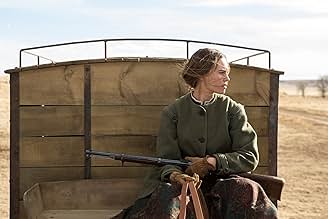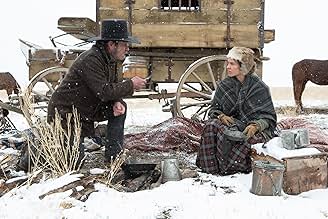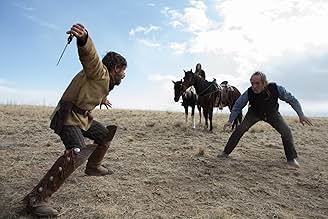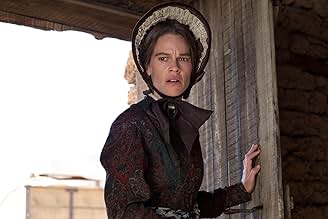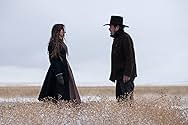Drei Frauen, die vom Pionierleben in den Wahnsinn getrieben wurden, sollen von der frommen, unabhängigen Mary Bee Cuddy mit Planwagen durchs Land befördert werden. Sie bittet George Briggs u... Alles lesenDrei Frauen, die vom Pionierleben in den Wahnsinn getrieben wurden, sollen von der frommen, unabhängigen Mary Bee Cuddy mit Planwagen durchs Land befördert werden. Sie bittet George Briggs um Hilfe.Drei Frauen, die vom Pionierleben in den Wahnsinn getrieben wurden, sollen von der frommen, unabhängigen Mary Bee Cuddy mit Planwagen durchs Land befördert werden. Sie bittet George Briggs um Hilfe.
- Auszeichnungen
- 5 Gewinne & 14 Nominierungen insgesamt
Empfohlene Bewertungen
I enjoy a good western but it would not be fair to this Tommy Lee Jones production to classify it as such without emphasizing the film is more than just a wagon trail journey of two unlikely characters across the rough and unforgiving western terrain. No, it is the story of two unlikely characters, a single and strong willed farmer named Mary Bee Cuddy played by Hilary Swank and a thieving drifter named George Briggs played by Tommy Lee Jones who agree to transport three women by wagon with real psychiatric (madness) problems from Nebraska to Idaho.
There have been hundreds of relatively good westerns produced in the past half century where the hero and heroine remain strong and stoic whilst riding through the barren lands their suits and dresses remain pressed and in pristine condition while their hair is coiffed perfectly, and miraculously the heroine's makeup never dries, cracks or runs. Well such is not the case in the Homesman.
Hilary Swank has never been afraid to shed the glamor of Hollywood and for her role as the stubborn, single, and capable farmer Mary Bee Cuddy the potential suitors that she asks to marry her turn her down and explain that she is far too plain looking, sexless, and too controlling in nature. So Mary Bee Cuddy agrees to make the arduous journey across the western plains maybe in the hope of finding a suitor in Idaho as she has run out of potential suitors in Nebraska and seems to be losing hope in raising a family on her own farm in Nebraska.
As Mary Bee Cuddy commences her journey she comes across someone even more homely and desperate than herself in the name of aging drifter George Briggs who is within minutes of losing his life at the end of a rope for illegally claiming mining rights to another persons staked property. The terms set forth by Mary Bee Cuddy before she will agree to free George Briggs from his futile situation and imminent death by hanging are simple. He must first agree to travel across the western plains of Nebraska to assist Mary Bee Cuddy in the transportation of three insane women to a church in Idaho where they will receive the care and attention they will require to survive.
And so the two hardened caretakers and their three insane passengers set out on their journey which I found to be not like any other western I had previously seen. This is not a humorous and light hearted western but a tough, grueling, and sad journey with what I was surprised provided unexpected results. Some people may not be happy with the last 30 minutes of this feature film, but this is actually where writer/actor/director Tommy Lee Jones hooked me with what I felt was a good feature film that ended strongly.
There are numerous cameos throughout the film including standout performances by Tim Blake Nelson as a lonesome cowboy, John Lithgow as Reverend Dowd, and Jesse Plemons as a derelict husband to one of the insane women. Look for mother Meryl Streep in Idaho as the Reverends wife Altha Carter who enjoys sharing the screen with her real life daughter Grace Gummer who plays one of the three insane women Arabella Sours.
I give the film a good 7 out of 10 rating.
There have been hundreds of relatively good westerns produced in the past half century where the hero and heroine remain strong and stoic whilst riding through the barren lands their suits and dresses remain pressed and in pristine condition while their hair is coiffed perfectly, and miraculously the heroine's makeup never dries, cracks or runs. Well such is not the case in the Homesman.
Hilary Swank has never been afraid to shed the glamor of Hollywood and for her role as the stubborn, single, and capable farmer Mary Bee Cuddy the potential suitors that she asks to marry her turn her down and explain that she is far too plain looking, sexless, and too controlling in nature. So Mary Bee Cuddy agrees to make the arduous journey across the western plains maybe in the hope of finding a suitor in Idaho as she has run out of potential suitors in Nebraska and seems to be losing hope in raising a family on her own farm in Nebraska.
As Mary Bee Cuddy commences her journey she comes across someone even more homely and desperate than herself in the name of aging drifter George Briggs who is within minutes of losing his life at the end of a rope for illegally claiming mining rights to another persons staked property. The terms set forth by Mary Bee Cuddy before she will agree to free George Briggs from his futile situation and imminent death by hanging are simple. He must first agree to travel across the western plains of Nebraska to assist Mary Bee Cuddy in the transportation of three insane women to a church in Idaho where they will receive the care and attention they will require to survive.
And so the two hardened caretakers and their three insane passengers set out on their journey which I found to be not like any other western I had previously seen. This is not a humorous and light hearted western but a tough, grueling, and sad journey with what I was surprised provided unexpected results. Some people may not be happy with the last 30 minutes of this feature film, but this is actually where writer/actor/director Tommy Lee Jones hooked me with what I felt was a good feature film that ended strongly.
There are numerous cameos throughout the film including standout performances by Tim Blake Nelson as a lonesome cowboy, John Lithgow as Reverend Dowd, and Jesse Plemons as a derelict husband to one of the insane women. Look for mother Meryl Streep in Idaho as the Reverends wife Altha Carter who enjoys sharing the screen with her real life daughter Grace Gummer who plays one of the three insane women Arabella Sours.
I give the film a good 7 out of 10 rating.
The Homesman is a watchable film depicting the old west in a more true, and less glorious, fashion that most westerns. At first it is confusing, with flashbacks to explain the story, but later it becomes clear.
Prarie madness sets in and three women are slated to be returned Back East. The problem is that one of the three "responsible" men is unwilling to step up, so a woman volunteers. She is strong and courageous, more than most men, but isolated and desperate for a husband because she is "bossy, and plain as an old tin can."
Her ultimate fate is incongruous, completely at odds with her character. A willful suspension of disbelief is required at this point.
Solid performances by Swank, Jones, Lithgow, and the actress who played the madwomen make it entertaining, if a bit long.
Prarie madness sets in and three women are slated to be returned Back East. The problem is that one of the three "responsible" men is unwilling to step up, so a woman volunteers. She is strong and courageous, more than most men, but isolated and desperate for a husband because she is "bossy, and plain as an old tin can."
Her ultimate fate is incongruous, completely at odds with her character. A willful suspension of disbelief is required at this point.
Solid performances by Swank, Jones, Lithgow, and the actress who played the madwomen make it entertaining, if a bit long.
Tommy Lee Jones has a wry, dry character -- rich and deep as unwatered open plains of the Americas. He's transferred his particular personality power to the story of The Homesman. He's successfully created a fine work of "auteur cinema" (much as I personally think this form rarely exists).
The Homesman is an emotionally and powerful, idea-rich, almost humorless story -- with an immense amount of humor. It has very tight, economic tale telling with no fat on the bone; in which much is implied, historical accuracy hits its target by nuance, and the story itself is deeply respectful of an intelligent audience.
The Homesman is not "entertainment" in the haha, shoot-'em-up Western sense. It's realism committed to a moral cause -- criticism of the disenfranchised, the homeless, the people who cannot make it no matter how hard they try. It has a brilliant sense of time and place that tells the life stories of dozens of hard-enduring, long-suffering "forgotten men" -- the women no less than the men.
The key heartbreaker is Hilary Swank's character of Miss Mary Bee Cuddy. She's born into a Western frontier world where she and everyone else believes and practices that "No man, having put his hand to the plough, and looking back, is fit for the kingdom of God." Hard workers and decent people. But tragically that is not enough. Why? The Homesman leaves that question deliciously unanswered. Life is not fair. God is not just.
Beautifully The Homesman does -- kind of -- answer life's problems with the value of sheer vitality and gutsiness itself. Thus that key visual motif in the movie that comes from: George Caleb Bingham, "The Jolly Flatboatmen". We must dance the dance of life, however mad.
The Homesman is an emotionally and powerful, idea-rich, almost humorless story -- with an immense amount of humor. It has very tight, economic tale telling with no fat on the bone; in which much is implied, historical accuracy hits its target by nuance, and the story itself is deeply respectful of an intelligent audience.
The Homesman is not "entertainment" in the haha, shoot-'em-up Western sense. It's realism committed to a moral cause -- criticism of the disenfranchised, the homeless, the people who cannot make it no matter how hard they try. It has a brilliant sense of time and place that tells the life stories of dozens of hard-enduring, long-suffering "forgotten men" -- the women no less than the men.
The key heartbreaker is Hilary Swank's character of Miss Mary Bee Cuddy. She's born into a Western frontier world where she and everyone else believes and practices that "No man, having put his hand to the plough, and looking back, is fit for the kingdom of God." Hard workers and decent people. But tragically that is not enough. Why? The Homesman leaves that question deliciously unanswered. Life is not fair. God is not just.
Beautifully The Homesman does -- kind of -- answer life's problems with the value of sheer vitality and gutsiness itself. Thus that key visual motif in the movie that comes from: George Caleb Bingham, "The Jolly Flatboatmen". We must dance the dance of life, however mad.
The Homesman, about a 31 year old (un-married/childless) woman (Hilary Swank) who takes up the challenge of bringing three crazed women across the Nebraska plains over five weeks with the help of a deserter-drifter left for dead (Jones), is in some ways meant to be a real Feminist Western (with a capital 'F'), and not in the way that a silly work like The Quick and the Dead was with Sharon Stone. Here, it's much more about depicting a time and place that was quite bleak and desolate and, in some spaces, without much hope. Ultimately Tommy Lee Jones, through the novel it's based on, sees a little more light at the end of the tunnel for his protagonist than, say, Eastwood did in Unforgiven. But it's a combination of things it's about, and emotionally the film does work quite well, in particular in the relationship that unfolds between the two leads.
If you're curious to see a western that has the love of the plains of the West visually speaking ala Ford, but has the dark contours of someone like Mann - and added to that those super dirty production designs and character realizations from Spaghetti Westerns - this might be it, at least up to a point. It's so unrelentingly dark in how it looks on at the deteriorating mental states of these women, and the desperation in the journey for Jones and Swanks' characters, that the few moments of humor are rather surprising - and welcome - especially when Jones first appears to Swank on the noose and the horse. It's the kind of scene that shows this actor, well into his 60's and pushing 70, trying something new in a performance (if only for a scene or two).
It's got a cast that is practically distracting for the who's who that shows up, mostly for one scene a piece: James Spader, Tim Blake Nelson, John Lithgow, William Fichtner, Meryl Streep (!) and Hailee Steinfeld (who appears almost to have wandered from the True Grit set to this one). There's so much going for the Homesman that it's a shame the script is uneven, and there's a plot twist two thirds of the way through that is sort of explained but not at all at the same time, and it leaves the film with a gaping tragedy that can never quite be filled. Interestingly, if you watch the behind the scenes on the blu-ray one of the screenwriters mentions the book left things unexplained as well. That might be fine in the book - or perhaps more was explained in other ways - but it still doesn't work, and what Jones goes for in awe-inspiring shots he leaves behind with some muddled story beats.
Nevertheless, The Homesman is a good Western, a solid western digging into the roots of the genre and mixing the unsavory and horrifying (not like a horror movie, just some repellant images at times, but for a point), though whether one will want to return to it like other, better Westerns is another story. It's the kind of picture I can't put down for its artistry, even if things can be looked at more critically, which may explain why it didn't find its way through the End-of-Awards-time (albeit it was accepted at Cannes).
If you're curious to see a western that has the love of the plains of the West visually speaking ala Ford, but has the dark contours of someone like Mann - and added to that those super dirty production designs and character realizations from Spaghetti Westerns - this might be it, at least up to a point. It's so unrelentingly dark in how it looks on at the deteriorating mental states of these women, and the desperation in the journey for Jones and Swanks' characters, that the few moments of humor are rather surprising - and welcome - especially when Jones first appears to Swank on the noose and the horse. It's the kind of scene that shows this actor, well into his 60's and pushing 70, trying something new in a performance (if only for a scene or two).
It's got a cast that is practically distracting for the who's who that shows up, mostly for one scene a piece: James Spader, Tim Blake Nelson, John Lithgow, William Fichtner, Meryl Streep (!) and Hailee Steinfeld (who appears almost to have wandered from the True Grit set to this one). There's so much going for the Homesman that it's a shame the script is uneven, and there's a plot twist two thirds of the way through that is sort of explained but not at all at the same time, and it leaves the film with a gaping tragedy that can never quite be filled. Interestingly, if you watch the behind the scenes on the blu-ray one of the screenwriters mentions the book left things unexplained as well. That might be fine in the book - or perhaps more was explained in other ways - but it still doesn't work, and what Jones goes for in awe-inspiring shots he leaves behind with some muddled story beats.
Nevertheless, The Homesman is a good Western, a solid western digging into the roots of the genre and mixing the unsavory and horrifying (not like a horror movie, just some repellant images at times, but for a point), though whether one will want to return to it like other, better Westerns is another story. It's the kind of picture I can't put down for its artistry, even if things can be looked at more critically, which may explain why it didn't find its way through the End-of-Awards-time (albeit it was accepted at Cannes).
I really liked the western "The Homesman", but I strongly suspect that it won't be to everyone's taste. And I will admit that even this die hard fan of westerns didn't find it a perfect movie. The opening thirty minutes of the movie, for one thing, are somewhat confusing with some details, though eventually everything comes together and the audience knows what's been going on. And after that first thirty minutes, the movie continues to test the patience of viewers by being quite slow moving and long (the movie is over two hours long.) But I stuck with the movie despite all those things, and I feel I was rewarded in the end. The atmosphere of the movie feels extremely authentic, showing many of the hardships life in the wild west gave many people. Though the story is slow-moving, there are a number of interesting vignettes along the way. And you probably won't predict what eventually happens - the major plot turn around the two-thirds mark really took me by surprise. The last scene is a little unclear as to where one of the characters is headed, but it is memorable all the same. As I said, the movie is not for all tastes, but western fans who are in a patient mood will likely embrace it despite its flaws.
Wusstest du schon
- WissenswertesGlendon Swarthout's novel was published in 1988. Paul Newman owned the rights, and wanted to direct the film himself. After several failed scripts, he gave up.
- PatzerDuring the Indian attack, every shot of the carriage has mountains in the background. The road from Nebraska to Iowa is nowhere near any mountains.
- Zitate
George Briggs: Are you an angel?
Mary Bee Cuddy: You're not dead.
George Briggs: Help me. Will you help me? For God's sake.
- VerbindungenFeatured in Film '72: Folge vom 19. November 2014 (2014)
- SoundtracksRosalie The Prairie Flower
Music & Lyrics by George Frederick Root (as George Fredrick Root)
Performed by Hilary Swank
Top-Auswahl
Melde dich zum Bewerten an und greife auf die Watchlist für personalisierte Empfehlungen zu.
- How long is The Homesman?Powered by Alexa
Details
- Erscheinungsdatum
- Herkunftsländer
- Offizieller Standort
- Sprachen
- Auch bekannt als
- Deuda de honor
- Drehorte
- Produktionsfirmen
- Weitere beteiligte Unternehmen bei IMDbPro anzeigen
Box Office
- Budget
- 16.000.000 $ (geschätzt)
- Bruttoertrag in den USA und Kanada
- 2.429.989 $
- Eröffnungswochenende in den USA und in Kanada
- 45.433 $
- 16. Nov. 2014
- Weltweiter Bruttoertrag
- 3.819.421 $
- Laufzeit
- 2 Std. 2 Min.(122 min)
- Farbe
- Sound-Mix
- Seitenverhältnis
- 2.39 : 1
Zu dieser Seite beitragen
Bearbeitung vorschlagen oder fehlenden Inhalt hinzufügen







